10 Surprising Facts About FDA-Approved Ketamine Therapy


July 16, 2025
Exploring the Truths, Efficacy, and Safety of Ketamine in Modern Medicine
As the landscape of mental health treatments evolves, FDA-approved ketamine therapies stand out for their rapid action and promising results. Despite growing popularity, many facts remain lesser-known or misunderstood. This article delves into ten surprising facts about FDA-approved ketamine therapy, shedding light on its regulatory status, mechanisms, safety features, and more, to help you understand this revolutionary treatment better.
FDA-Approved Esketamine for Depression - Key Facts
- In 2019, FDA approved esketamine (Spravato®) as the first nasal spray for treatment-resistant depression (TRD).
- Esketamine is indicated for adults unresponsive to at least two other antidepressants, including cases with suicidal ideation.
- Its administration requires strict medical supervision in healthcare settings with at least two hours monitoring post-dose.
- Esketamine is regulated under a Risk Evaluation and Mitigation Strategy (REMS) to ensure safe use and prevent misuse.
- The mechanism involves NMDA receptor antagonism leading to glutamate surge, BDNF upregulation, and neuroplasticity; promoting rapid antidepressant effects.
- FDA-approved ketamine treatments are generally safe when administered under supervision, but unregulated use poses serious health risks.
- Clinical trials show that esketamine provides rapid symptom relief, often within 24 hours, especially for TRD patients.
- While effective short-term, the effects may diminish, requiring multiple sessions or maintenance schedules for sustained benefits.
- Esketamine is a Schedule III controlled substance, with strict regulations setting it apart from off-label or illicit ketamine use.
- In 2025, the FDA granted full approval for esketamine as a standalone treatment for adults with TRD, marking a paradigm shift in depression therapy.
1. FDA-Approved Nasal Spray: Esketamine (Spravato®) for Treatment-Resistant Depression
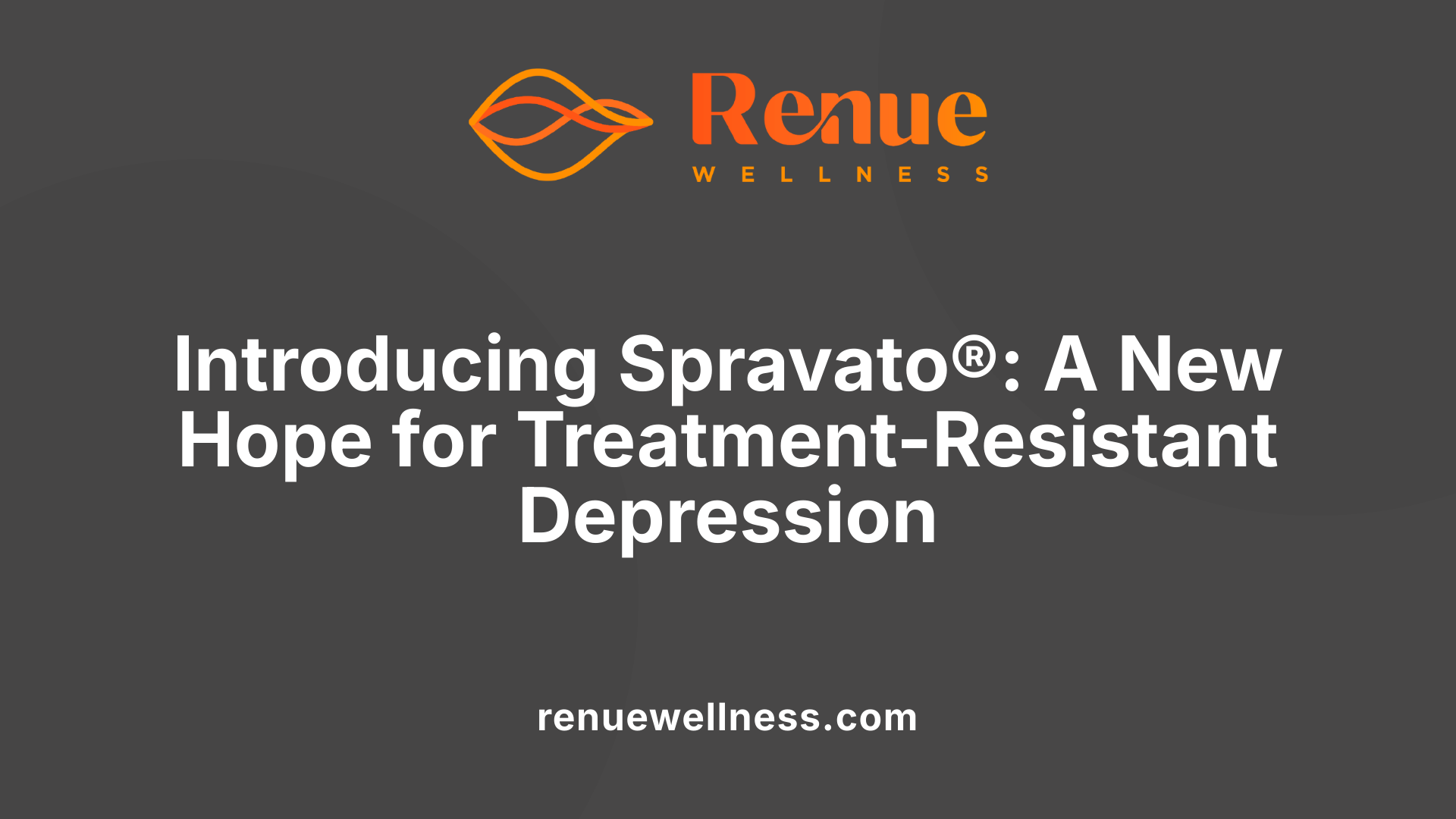 In 2019, the U.S. Food and Drug Administration (FDA) approved esketamine, marketed as Spravato®, as a nasal spray for the treatment of treatment-resistant depression (TRD). This marked a significant milestone, as it was the first nasal spray directly targeting depression, offering hope to patients unresponsive to traditional antidepressants.
In 2019, the U.S. Food and Drug Administration (FDA) approved esketamine, marketed as Spravato®, as a nasal spray for the treatment of treatment-resistant depression (TRD). This marked a significant milestone, as it was the first nasal spray directly targeting depression, offering hope to patients unresponsive to traditional antidepressants.
Esketamine is specifically indicated for adults who have not responded adequately to at least two other antidepressant treatments. Its approval also extends to cases involving suicidal ideation, making it a critical option in acute mental health crises.
The administration of esketamine requires strict medical supervision. It is administered in a healthcare setting where patients are monitored continuously for at least two hours post-dose. This monitoring helps manage common side effects, including elevated blood pressure, dizziness, and feelings of detachment. The drug is given via nasal spray, which is designed to allow easy outpatient use for eligible patients.
Due to its potential for misuse and side effects, the FDA regulates esketamine under a Risk Evaluation and Mitigation Strategy (REMS). This program ensures the drug's safe use, with healthcare providers following specific protocols for prescription, administration, and patient follow-up.
Overall, the FDA's approval of esketamine signifies recognition of its benefits in rapid symptom relief for difficult-to-treat depression, setting the stage for improved treatment protocols in mental health care.
2. Mechanism of Action: How FDA-Approved Esketamine Facilitates Rapid Relief
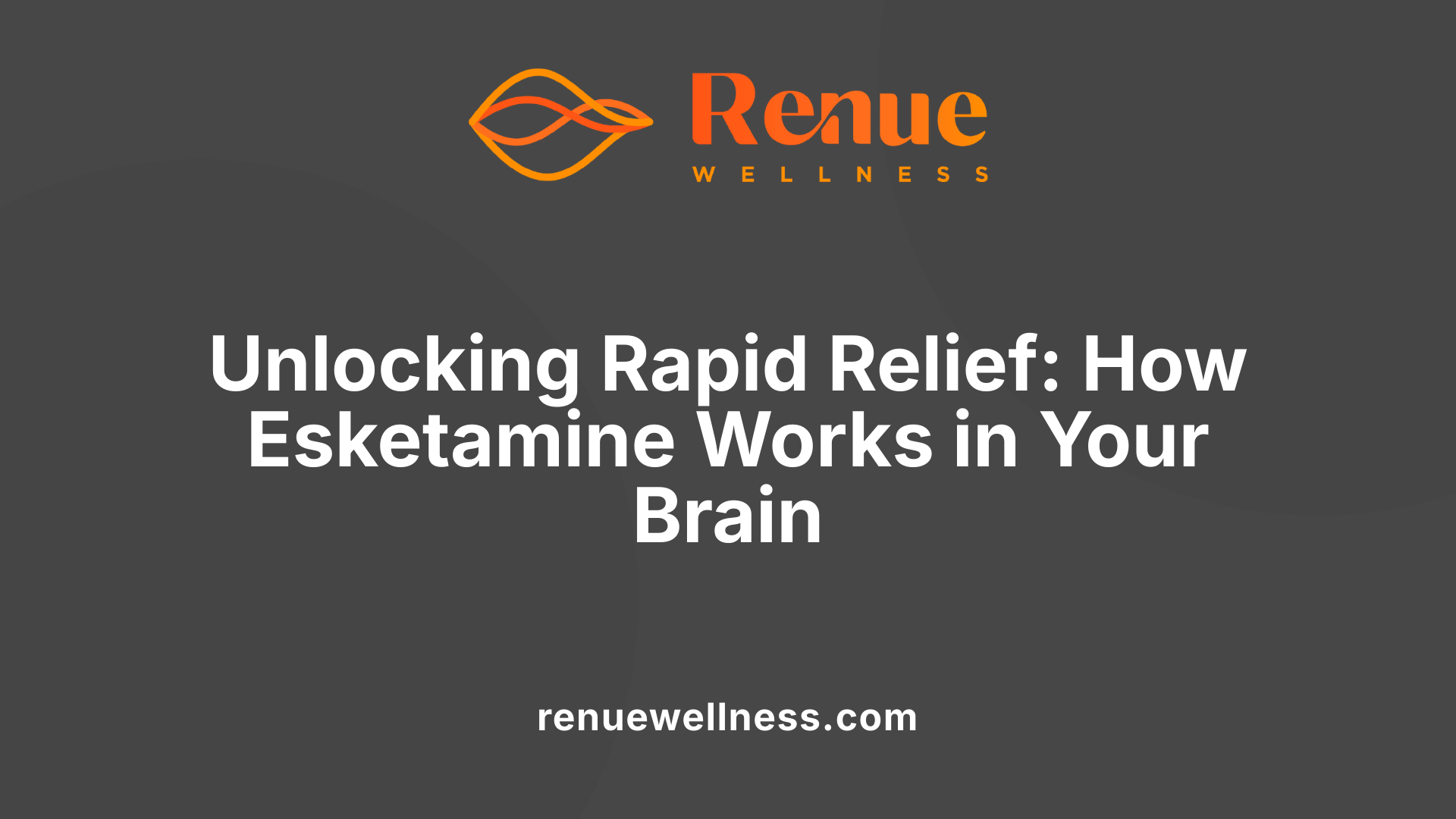
NMDA receptor antagonism
Ketamine’s therapeutic effects stem from its role as an NMDA receptor antagonist. By selectively blocking these glutamate receptors, ketamine disrupts abnormal excitatory signaling in the brain. This blockade particularly impacts inhibitory GABAergic interneurons, leading to a disinhibition of pyramidal neurons, which results in a surge of glutamate release.
Glutamate surge and neuroplasticity
The increase in glutamate activates alpha-amino-3-hydroxy-5-methyl-4-isoxazolepropionic acid (AMPA) receptors, enhancing excitatory neurotransmission. This surge triggers the mTOR signaling pathway, which is crucial for promoting synaptic growth and strengthening. The rapid activation of this cascade fosters the formation of new neural connections, a process known as synaptogenesis.
Role of BDNF and synaptogenesis
A central player in this process is Brain-Derived Neurotrophic Factor (BDNF), a protein that supports the growth, survival, and differentiation of neurons. Ketamine’s action elevates BDNF levels, facilitating synaptogenesis and neuroplasticity., which are vital for reversing neuronal atrophy associated with depression.
| Aspect | Description | Additional Details |
|---|---|---|
| NMDA Receptor Blockade | Inhibition of glutamate receptors to modulate excitatory signaling | Disinhibition of pyramidal neurons |
| Glutamate Surge | Increased release of glutamate to activate other receptors | Leads to activation of AMPA receptors and downstream pathways |
| BDNF Upregulation | Elevated BDNF levels support neuroplasticity and neuronal growth | Important for long-term mood improvement |
| Synaptogenesis | Formation of new synaptic connections | Reverses stress-induced neuronal damage |
Research highlights that this multi-faceted mechanism underlies ketamine’s rapid onset of antidepressant effects, providing immediate relief while promoting long-term neural recovery. The process involves a complex cascade of signaling events culminating in increased neuroplasticity, ultimately restoring healthy brain function in individuals with depression.
Understanding this mechanism has paved the way for developing faster-acting antidepressants like esketamine, delivered via nasal spray, which leverages these neuroplasticity pathways for effective treatment.
3. Safety Profile: Supervised Use and Monitoring in FDA-Approved Ketamine Therapies
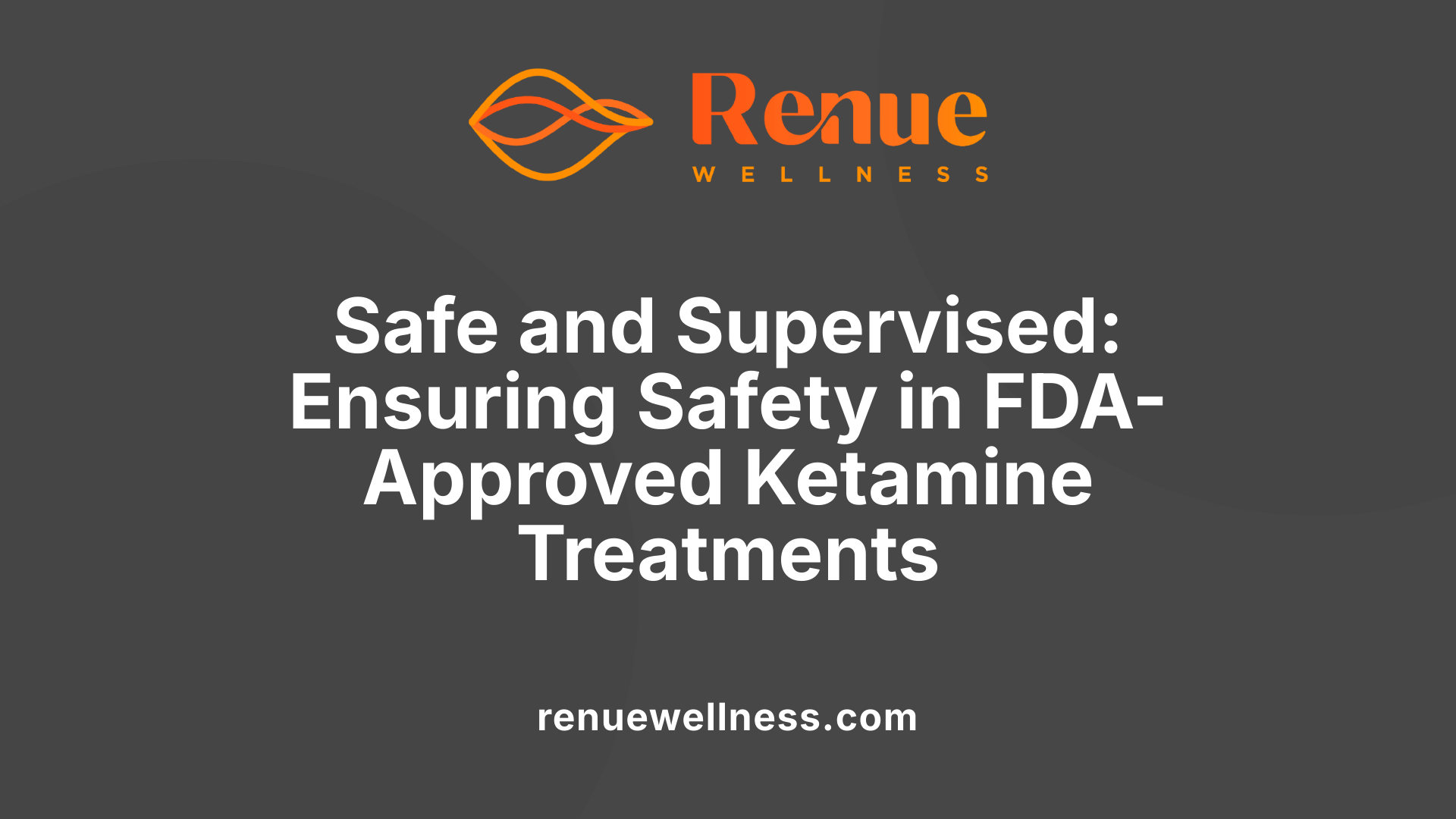
What safety considerations and risks are associated with FDA-approved ketamine therapy?
FDA-approved ketamine therapy, particularly with medications like esketamine (Spravato), is administered within strict clinical settings under the supervision of qualified healthcare professionals. Patients are closely monitored for common side effects such as dizziness, increased blood pressure, dissociation, and nausea during and after treatment sessions. Medical practitioners conduct thorough assessments before administering therapy to ensure patient safety, especially for those with underlying health conditions.
However, the safety profile of FDA-approved treatments relies on proper adherence to dosing protocols and monitoring guidelines. In contrast, the use of compounded ketamine formulations outside of regulated environments introduces serious safety risks. These unregulated products lack standardized dosing, quality control, and consistent manufacturing, increasing the chances of overdose, unpredictable drug reactions, and severe adverse events.
Misuse and recreational use further compound safety concerns. Illicit or non-medical use of ketamine can lead to hallucinations, disorientation, respiratory depression, urinary tract problems, and even life-threatening complications. Patients with conditions like psychosis, current substance use disorders, or pregnancy are at higher risk of adverse effects.
Long-term safety data on repeated or chronic ketamine use remains limited. Potential concerns include neurotoxicity, cognitive impairments, and urinary tract damage, especially with frequent or high-dose exposure. The overall picture emphasizes that while FDA-regulated ketamine treatments are generally safe under strict supervision, the broader use of ketamine without medical oversight presents substantial health risks that require ongoing research and vigilance.
4. Efficacy of FDA-Approved Ketamine Therapies in Rapidly Alleviating Depression
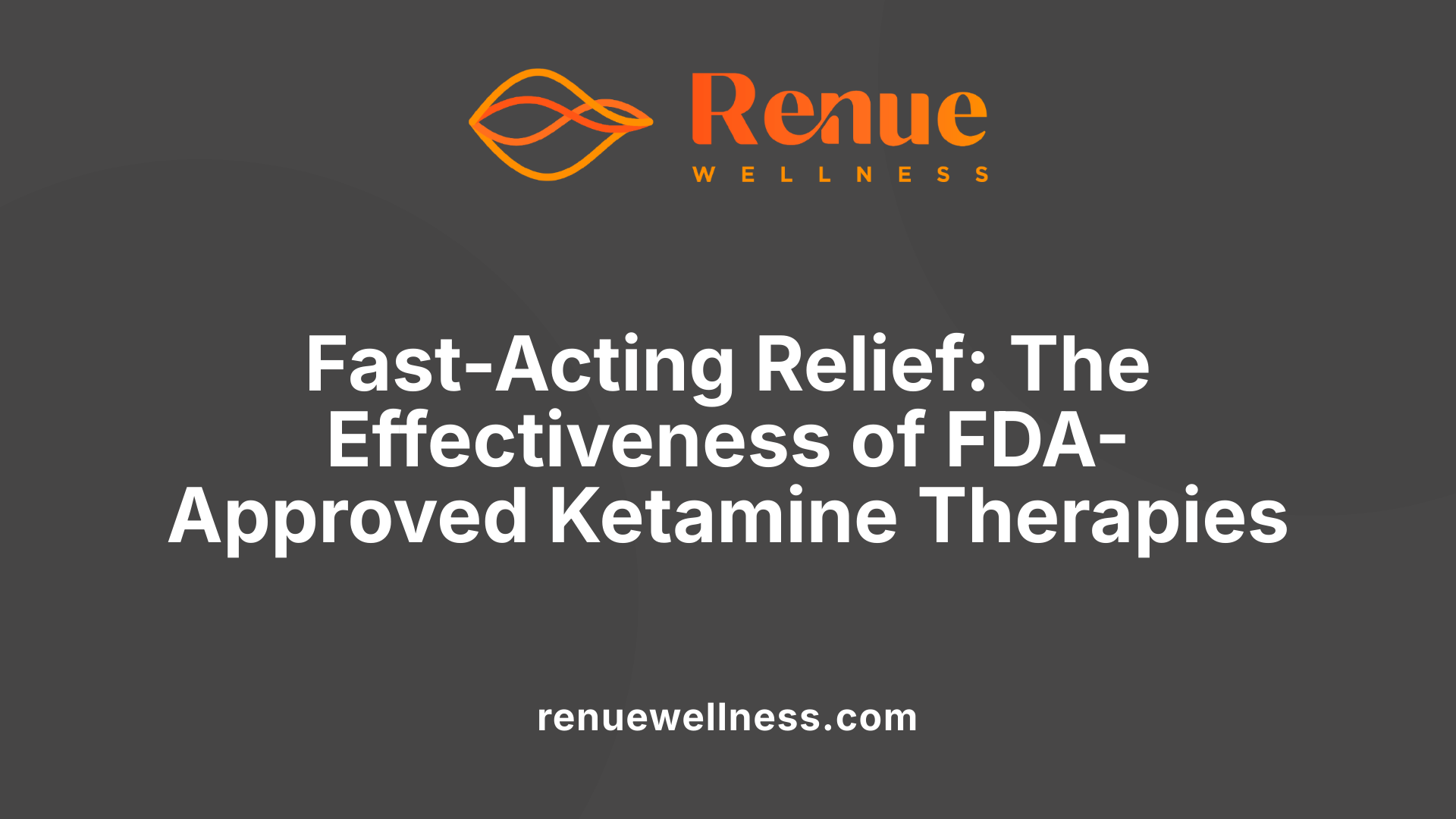
How effective is FDA-approved ketamine therapy, particularly for depression?
FDA-approved ketamine treatments, such as the esketamine nasal spray (brand name Spravato), have shown substantial promise in rapidly alleviating depressive symptoms, especially in cases of treatment-resistant depression (TRD). Clinical trials have demonstrated that intravenous ketamine can lead to quick symptom relief, often within a matter of hours. Patients frequently experience mood improvements that may last from several days up to a few weeks post-treatment.
In 2019, the U.S. Food and Drug Administration (FDA) approved esketamine as a nasal spray for TRD based on rigorous evidence supporting its effectiveness. These trials included adults who had not responded to conventional antidepressant therapies. Results indicated significant reductions in depression severity scores within 24 hours of administration, highlighting the medication's rapid action.
Both ketamine and esketamine are generally well tolerated when administered under medical supervision. Common side effects are usually transient and include dissociative sensations, dizziness, and mild increases in blood pressure. Researchers are actively studying how to extend the duration of benefits and identify which patients are most likely to respond. Overall, these therapies are heralded as promising rapid-acting options for depression, changing the landscape of mental health treatment by providing swift relief for those with limited options.
Clinical trial results
| Study | Results | Duration of Effect | Side Effects | Notes |
|---|---|---|---|---|
| Randomized controlled trial (2019) | Significant reduction in depression scores within 24 hours | Up to 2 weeks | Mild dissociation, increased blood pressure | FDA approval based on these findings |
| Long-term studies | Improved symptom control over several months when combined with other therapies | Several months with ongoing sessions | Similar transient side effects | Ongoing research aims to optimize long-term outcomes |
Duration and sustainability of effects
While ketamine and esketamine can deliver immediate symptom relief, the effects often diminish after a week or two. Therefore, multiple sessions or continuous dosing schedules are usually necessary to sustain benefits. Studies suggest that maintenance treatment, including repeated infusions or nasal sprays, can help prolong remission. However, the long-term safety and efficacy data remain limited, emphasizing the importance of careful monitoring.
Comparison with traditional antidepressants
Traditional antidepressants like SSRIs or SNRIs typically take several weeks to exhibit noticeable effects and are less effective for TRD cases. In contrast, ketamine-based therapies act rapidly—within hours—making them invaluable for urgent symptom relief. Additionally, ketamine's mechanism, involving glutamate modulation rather than serotonin, offers a different therapeutic pathway, which may explain its efficacy in patients unresponsive to conventional drugs. Despite their benefits, ketamine therapies are often used alongside traditional treatments rather than as a standalone cure, providing a comprehensive approach to managing depression.
5. Regulatory and Legal Aspects: Oversight and Restrictions on FDA-Approved Ketamine Treatments
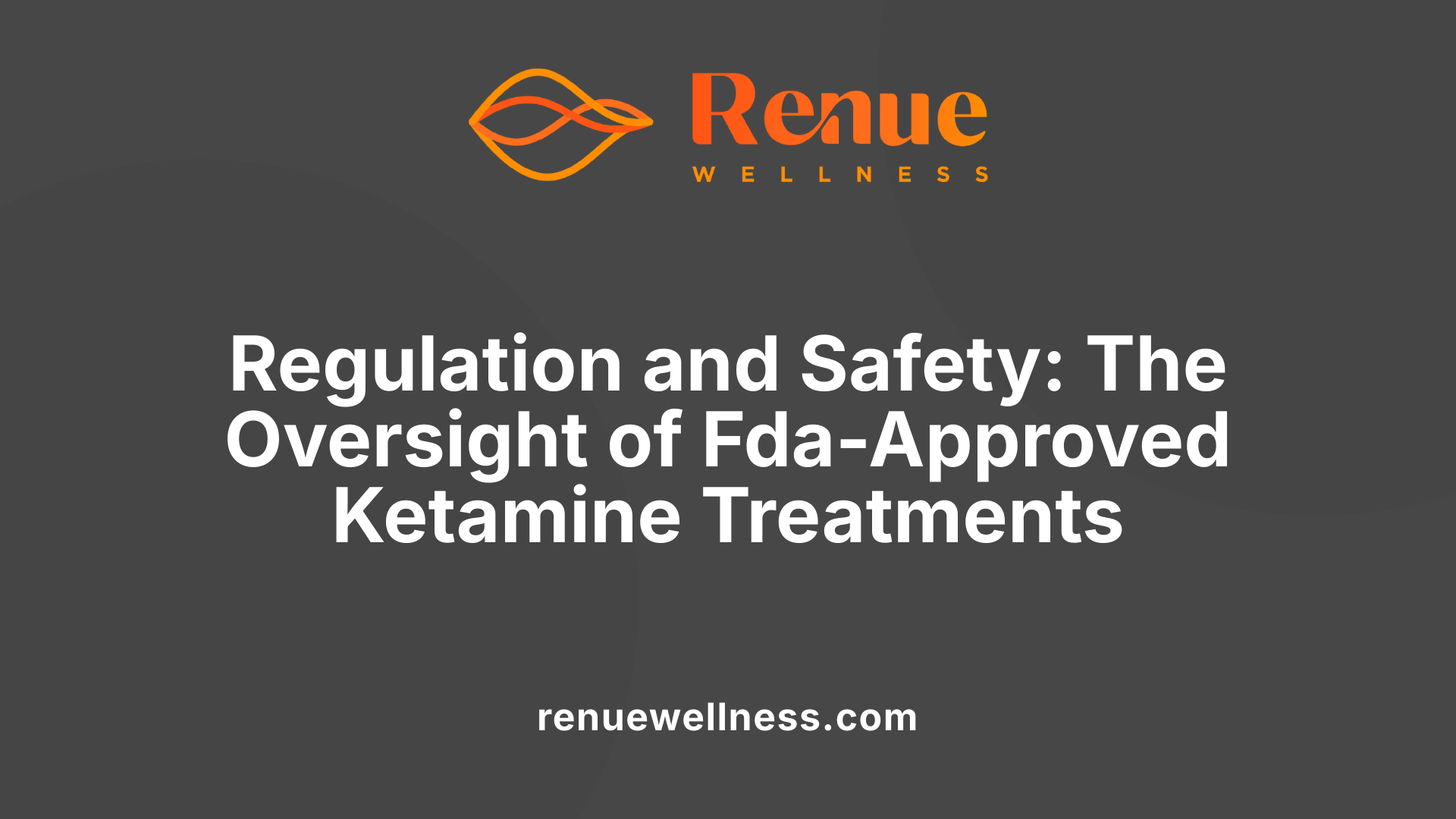 Ketamine and its derivative esketamine are classified as Schedule III controlled substances, reflecting their accepted medical use but also their potential for misuse and dependence. In the United States, the FDA approved esketamine nasal spray (brand name Spravato®) specifically for treatment-resistant depression in 2019. Due to the potential risks, the FDA mandated a Risk Evaluation and Mitigation Strategy (REMS) program for esketamine, ensuring that it is administered only in certified medical settings under professional supervision. This regulation aims to minimize misuse, monitor patient safety, and manage side effects like increased blood pressure and dissociation.
Ketamine and its derivative esketamine are classified as Schedule III controlled substances, reflecting their accepted medical use but also their potential for misuse and dependence. In the United States, the FDA approved esketamine nasal spray (brand name Spravato®) specifically for treatment-resistant depression in 2019. Due to the potential risks, the FDA mandated a Risk Evaluation and Mitigation Strategy (REMS) program for esketamine, ensuring that it is administered only in certified medical settings under professional supervision. This regulation aims to minimize misuse, monitor patient safety, and manage side effects like increased blood pressure and dissociation.
While esketamine enjoys specific approval, traditional racemic ketamine—administered intravenously—remains unapproved by the FDA for psychiatric conditions. Its off-label use in clinics is common but less regulated, often varying by state and medical facility policies. This off-label practice, although legal when performed by licensed professionals, carries risks due to inconsistent standards and lack of standardized protocols.
Internationally, other regulatory bodies, such as the European Medicines Agency, have also approved intranasal esketamine for depression, signifying growing global acceptance. However, in many regions, the unregulated use of ketamine outside clinical settings remains risky, with concerns over misuse, abuse, and the use of compounded products lacking quality control.
In summary, the regulatory landscape emphasizes controlled access to ketamine-based treatments. Approved formulations like esketamine are tightly regulated, ensuring safe administration in healthcare settings. Off-label uses and recreational misuse are subject to legal restrictions and professional oversight, but variability persists. Awareness of these frameworks is essential for providers and patients to support safe, effective, and legal use of ketamine therapies.
6. Long-Term Safety and Continued Research in FDA-Approved Ketamine Treatments
What safety considerations and risks are associated with FDA-approved ketamine therapy?
FDA-approved ketamine treatments, such as esketamine (Spravato), are provided in controlled clinical environments with rigorous monitoring to minimize risks. Patients are closely observed for side effects like dissociation, increased blood pressure, dizziness, and psychiatric symptoms. These safety protocols are essential because sudden adverse reactions can occur during administration.
In contrast, the use of non-regulated, compounded ketamine outside healthcare settings presents significant hazards. Unsupervised use or self-medication can lead to overdose, respiratory depression, urinary tract problems, and unpredictable psychological effects. The lack of standard dosing and monitoring in such practices increases the chance of serious adverse events.
Certain populations, including pregnant women, individuals with psychosis or substance use disorders, face heightened risks when using ketamine. Long-term safety data, particularly regarding cognitive effects and urinary tract health, remains limited. This lack of comprehensive long-term research fuels ongoing concerns about potential neurotoxicity and persistent cognitive impairments.
While FDA-approved formulations are deemed relatively safe when administered under strict supervision, the broader scenario involving unregulated use underscores the need for further investigation. Continued research aims to understand the full spectrum of long-term effects and improve treatment protocols, ensuring a favorable risk-benefit balance for patients suffering from treatment-resistant depression and other conditions.
7. Distinct Features of FDA-Approved Ketamine Treatments Compared to Off-Label Uses
FDA-approved ketamine treatments, primarily represented by esketamine (brand name Spravato®), are distinguished by strict regulatory standards, specific approved indications, and controlled administration protocols. Approved in 2019 for treatment-resistant depression and suicidal ideation, esketamine is a nasal spray that undergoes rigorous review by the FDA to ensure safety, efficacy, and consistent dosing. This approval signifies that the drug’s use for mental health conditions is backed by substantial clinical evidence, and its administration is closely monitored within specialized clinics.
The FDA mandates that esketamine be administered only under medical supervision, with continuous patient monitoring post-treatment. Its standardized dose, typically delivered via nasal spray, increases accessibility and ensures predictable treatment outcomes. Insurance coverage is often available for FDA-approved applications, further enhancing its integration into mainstream healthcare.
In contrast, ketamine itself remains an off-label treatment for depression, often administered by infusion in clinics without specific FDA approval for psychiatric uses. These off-label uses lack the same standardized protocols, which can lead to variability in dosing and safety practices. Furthermore, illicit or recreational forms of ketamine are obtained without medical oversight, posing significant risks including overdose, cognitive impairments, and unpredictable psychological effects.
The critical differences lie in regulatory oversight, with FDA approval for esketamine offering a framework that emphasizes safety, consistent dosing, and proper clinical monitoring. On the other hand, off-label and unregulated use of ketamine lacks these protections, increasing potential health risks. The route of administration also varies; esketamine is inhaled, providing a more accessible outpatient option, whereas traditional ketamine treatment often involves intravenous infusions. These regulatory distinctions aim to maximize therapeutic benefits while minimizing risks, supporting safer and more reliable treatment options for patients.
| Feature | FDA-Approved Ketamine (Esketamine) | Off-Label/Illicit Ketamine | Regulatory and Safety Implications |
|---|---|---|---|
| Approval Status | FDA-approved for depression and suicidal ideation | Not specifically approved for mental health | Clear guidelines and legal protections |
| Administration Method | Nasal spray (Spravato®), monitored in clinics | Usually IV infusion, unregulated | Ensures safety, supervised use |
| Dosing | Strictly regulated, standardized | Variable, often unstandardized | Consistent dosing reduces overdose risk |
| Monitoring | Mandatory post-administration monitoring | No regulatory oversight | Enhances safety and treatment outcomes |
| Accessibility | Medically supervised clinics, covered by insurance | Self-medication, illegal markets | Safer, more controlled treatment environment |
| Safety and Efficacy Data | Supported by clinical trials | Limited data, potential safety concerns | Ensures evidence-based practice |
Understanding these differences helps clarify how FDA-approved esketamine treatment offers a controlled, safe, and effective option for patients suffering from severe depression, contrasting with the risks associated with unregulated or recreational use of ketamine.
8. Risks and Precautions: Safety Considerations of FDA-Approved Ketamine Therapy
What safety considerations and risks are associated with FDA-approved ketamine therapy?
FDA-approved ketamine treatments, such as the nasal spray esketamine (brand name Spravato), are administered in healthcare settings under strict medical supervision. Patients are carefully monitored for common side effects like dissociation, dizziness, increased blood pressure, and nausea. Medical professionals assess each individual's health status to minimize potential adverse reactions.
Despite these safeguards, there are notable risks when ketamine is used outside regulated environments. Off-label or compounded formulations—prepared without FDA oversight—pose significant dangers, including overdose, unpredictable reactions, and serious side effects. These unregulated uses may involve higher doses or improper administration, heightening the risk of respiratory depression, urinary tract issues, and cognitive impairments.
Certain populations require extra caution. Patients with a history of psychosis, substance use disorder, or pregnancy may experience exacerbated side effects or adverse outcomes. The safety profile of long-term ketamine use is still under study, and concerns about cognitive decline, urinary problems, and potential neurotoxicity persist.
In regulated clinical settings, the structured protocol and professional oversight greatly reduce these risks, ensuring patient safety. However, broader use—particularly in non-medical, home-based, or online clinic settings—lacks standardization and can lead to dangerous consequences.
In summary, while FDA-approved ketamine therapies like Spravato are generally safe when administered appropriately, unregulated or illicit uses carry substantial safety risks. It emphasizes the importance of receiving ketamine treatment solely under the guidance of qualified healthcare professionals to mitigate potential harms.
9. Future Directions: Research and Regulation of FDA-Approved Ketamine Treatments
Recent research into ketamine treatments continues to uncover ways to improve its safety, effectiveness, and understanding of its mechanisms. Scientists are studying biomarkers that could predict a patient’s response to therapy, helping tailor treatments more precisely. For example, some studies examine gamma oscillations and other neural signals that correlate with positive outcomes, aiming to optimize patient selection.
Advancements are also focused on safety protocols. Researchers are developing enhanced monitoring during infusions, standardizing dosing schedules, and exploring alternative administration routes like sublingual or oral formulations to reduce risks and improve accessibility.
Long-term studies are essential as well. These investigations evaluate the durability of ketamine’s antidepressant effects, which often fade within weeks of treatment. Extended trials, such as the Bio-K study, involve repeated dosing strategies and combined therapies like talk therapy, demonstrating promising remission rates for treatment-resistant depression.
Efforts are underway to understand the molecular and neural circuit mechanisms underlying ketamine’s effects. Findings related to synaptic plasticity, signaling pathways like ERK, and metabolite actions, such as RR-HNK, are being explored to develop safer, longer-lasting treatment options.
Overall, ongoing research endeavors aim to establish standardized, evidence-based guidelines that could influence future regulation. This includes integrating biomarkers for response prediction, improving safety protocols across clinics, and extending therapeutic benefits through innovative approaches. These advancements promise to make ketamine treatments more effective and accessible while maintaining safety for patients.
10. Access and Cost: Economic and Regulatory Considerations in FDA-Approved Ketamine Therapy
What safety considerations and risks are associated with FDA-approved ketamine therapy?
FDA-approved ketamine therapy, such as esketamine (brand name Spravato), is administered in specialized clinical settings under strict medical supervision. Patients are closely monitored during and after treatment for common side effects like dissociation, dizziness, increased blood pressure, and psychiatric symptoms such as anxiety or agitation. This careful oversight helps mitigate serious adverse reactions and ensures safe use.
However, the safety landscape differs significantly when ketamine is used off-label or in compounded forms not approved by the FDA. These unregulated formulations pose substantial risks, including overdose, unpredictable reactions, and misuse. Without standardized dosing and professional supervision, patients may experience severe side effects such as respiratory depression, urinary tract issues, or cognitive impairments.
Use of compounded ketamine outside controlled medical environments, especially without proper monitoring, increases the danger of overdose and serious health complications. Patients with pre-existing conditions like psychosis, substance use disorder, or pregnancy may face heightened risks when exposed to non-standardized or unregulated ketamine. The long-term safety and cognitive effects of repeated use remain under-researched, adding to safety concerns.
In summary, FDA-approved ketamine treatments administered by healthcare professionals are generally safe when protocols are followed. Nonetheless, the broader use of ketamine, especially outside regulated settings, involves significant safety risks requiring careful management, adequate medical supervision, and further research to better understand long-term effects.
FDA's Full Approval for Esketamine Marks a New Era in Depression Treatment
What is the FDA approval status of ketamine therapy?
As of October 2023, ketamine itself is not officially approved by the U.S. Food and Drug Administration (FDA) for the treatment of depression or other mental health conditions. Instead, the FDA has approved a closely related compound, esketamine, which is a chemically similar nasal spray derived from ketamine. This approval was granted in March 2019 for patients with treatment-resistant depression (TRD), providing a new, fast-acting option for those who have not responded to traditional antidepressants.
Esketamine is administered in specialized clinics under strict medical supervision, usually alongside oral antidepressants. Its mechanism involves modulating the glutamate system in the brain, leading to rapid symptom relief in some patients.
In January 2025, after several years of accumulating evidence, the FDA granted full approval for esketamine (Spravato) as a standalone treatment for adults with TRD. This marks a significant milestone, confirming its safety and efficacy based on extensive clinical trial data. The approval was based on findings that showed sustained antidepressant effects and rapid symptom improvement, often within hours or days.
Apart from TRD, esketamine has received additional FDA clearances for use in major depressive disorder (MDD) with suicidal thoughts and behaviors, highlighting its expanding role in severe depression treatments. While ketamine itself remains legally classified for anesthetic use and is often administered off-label for mental health conditions, esketamine now enjoys a formal, regulatory endorsement for specific depression indications.
In essence, this development signifies a paradigm shift in depression care, emphasizing fast-acting options in mental health treatment protocols. It also underscores an increasing reliance on novel neuroplasticity-based therapies that break from traditional antidepressant approaches, which often take weeks to produce benefits.
The Future of FDA-Approved Ketamine Therapies
FDA-approved ketamine treatments, particularly esketamine nasal spray, are transforming mental health care by providing rapid relief for treatment-resistant depression and other conditions. Strong regulatory oversight ensures safety, efficacy, and standardized dosing, making these therapies a vital component of modern psychiatric practice. Ongoing research and evolving regulations aim to improve long-term safety, accessibility, and personalized treatment approaches, promising a new era of mental health management that combines scientific innovation with patient safety. As understanding and technology advance, FDA-approved ketamine therapies are poised to become more effective, accessible, and integrated into comprehensive care plans, offering hope to millions worldwide.
References
- 20 Amazing Facts You'd Love to Know about Ketamine for Depression
- Fast Facts About Ketamine for Depression | University of Utah Health
- Debunking the Top 10 Misconceptions About Ketamine Therapy
- What to Know About Ketamine | Johns Hopkins
- Ketamine | National Institute on Drug Abuse (NIDA)
- How Ketamine Drug Helps with Depression > News > Yale Medicine
- 4 Things to Know About Ketamine Therapy - AARP
- Ketamine economy: New mental health clinics pop up with few rules
- Ketamine: Miracle Drug or Double-Edged Sword? | Psychiatric News
- 9 Things to Do to Maximize the Impact of Ketamine Therapy for ...
Recent Posts
Conditions Treated
AnxietyDepressionOCDPTSDPostpartum DepressionPain ManagementSubstance AbuseSuicidal IdeationOur Location


